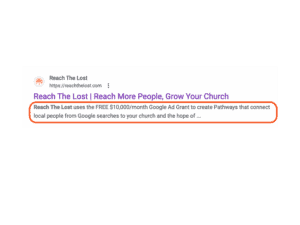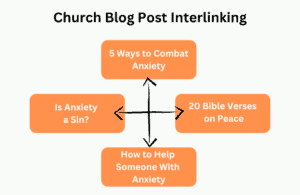Blog posts are a great way to attract potential visitors to your church website and spread the message of Jesus. So how do you make sure people are finding your blog posts online? That’s where search engine optimization (SEO) comes in. Optimizing your church blog post for search engines increases the chances of people finding your blog post on Google search pages. We’re excited to share 5 SEO blog writing tips to help your church reach your community.
What is Church Blog SEO and How Can It Help My Church?
Google processes billions of searches every day. For every search query, Google scours its content database to determine the most helpful information for users. Church Blog SEO is the process of helping your church blog posts show up on search engine result pages.
More and more people are wrestling with marital difficulties, big questions about God, mental health problems, grief, addiction, etc., and they are searching for help online. With blog SEO, you can address the felt needs in your community and offer a voice of hope within search engine results.
For example, if your church blog post targets the phrase “how to find inner peace,” it could appear in search results when someone uses a similar search term, providing support and potentially leading them to your church doors.
Church blog writing for SEO also increases your church website’s authority. If you consistently produce high-quality content for users, Google will recognize your site as a trusted source of information.
Tip 1: Create Content Relevant to Your Community
Before you start blog writing for SEO, get to know your audience. What words and phrases are people in your local community searching for in Google? By identifying these keywords, you’ll discover blog post topics your community wants to read. This is an SEO process called keyword research.
When researching keywords for blog posts, it might be helpful to create a list of generic topics relevant to your audience. From there, you can identify the specific keyword phrases related to each topic. There are many different local SEO tools to help your keyword research such as Google Keyword Planner and Google Trends.
After you build a keyword list, you’ll also have a solid list of blog post ideas. Now it’s time to incorporate those keywords into your content. Just be careful not to over-stuff your blog posts with the same keyword. Keyword stuffing is not as user-friendly and can lower your rankings in Google.
Tip 2: Optimize Your Title, Meta Description, and URL
Your blog post title is the first thing your audience will read on search pages so it’s important to make a good first impression. You can edit your blog post title using the <title> HTML tag in your page code. When creating a click-worthy title, you’ll want to make sure it’s between 50-60 characters and includes your main keyword.

It’s also important to consider the intent behind your main keyword when determining a blog title. For example, if your church is writing a blog post to go after the keyword “how to Create a Bible study” you first need to consider why your audience is using this search term. Is your audience hoping to learn how to write a Bible study curriculum? Or are they hoping to learn how to start a Bible study from their church or home?
Next, it’s time to turn your attention to your meta description. A meta description provides a summary of your blog post on the search engine result page (SERP), below your blog post title. Meta descriptions may also show up on social media when you share your blog post.
You can optimize your blog post’s meta description on the HTML side of your page in the <head> tag. When writing your meta description, it’s best to include at least one of your target keywords and keep it around 120 characters so Google does not cut off the text. Your meta description often determines if someone clicks on your blog post, so make sure it includes a click-worthy call to action.
Finally, take a look at your blog post URL. Does your URL clue your readers in on what your blog post is about? Does it include your main keyword? Does it show your audience where they’re at on your church website? Your URL doesn’t have to include every word of your title as long as it’s clean, simple, and includes your main keyword.
Tip 3: Incorporate Videos, Photos, and Infographics
Adding rich media such as videos, audio, and images to your blog post creates a more engaging and memorable experience for your readers. Additionally, rich media can increase traffic to your post through social media sharing and Google image searches.
It’s good SEO practice to include your main keyword in your image file name and alt text description. Alt text tells search engines and page-reading devices what the image is about.
To improve Church SEO blog writing, we recommend creating original media. However, free stock photo sites like Unsplash or Flickr can also be used. Either way, make sure to choose high-quality, unique, and relevant images with a small file size for faster loading.
Tip 4: Link to Content on Your Website
Internal linking is crucial for creating an SEO-friendly blog post. Linking to other pages on your church website lowers your bounce rate, provides more high-quality content for your readers, and establishes your authority on the topic to Google.

We recommend linking to at least two blog posts that you’ve already published. For example, if you’re writing a blog post on how to combat anxiety, try linking to a past blog post on peace. When you’re linking to a post, make sure the anchor text is short and sweet – just 1-5 words that preview what the post is about.
Tip 5: Create Easy-to-Read Text
While Google loves longer blog posts (1,500-2,500 words), lengthy articles can overwhelm your audience. Create skimmable blog posts by writing short paragraphs (50-100 words), organizing your text with headers and subheaders, bolding main ideas, and adding bullet points when needed. Make it easy for your audience to scan through your post and still get the main ideas. Because, let’s be honest, no one has time to read a novel-length article.
What’s Next?
Which of these 5 Church SEO tips will you try in your next blog post? Once you’ve mastered blog writing for SEO, it’s time to optimize the rest of your church content. The good news is we have even more SEO tips up our sleeve! From custom marketing campaigns to Google Ad grants, we’re here to get your church content ranking higher in Google.
For more SEO tips, check out these articles:





